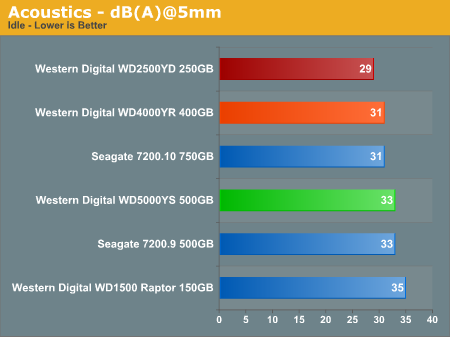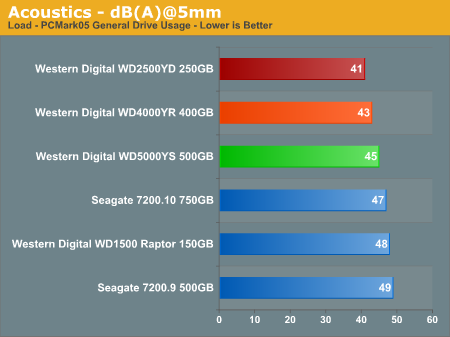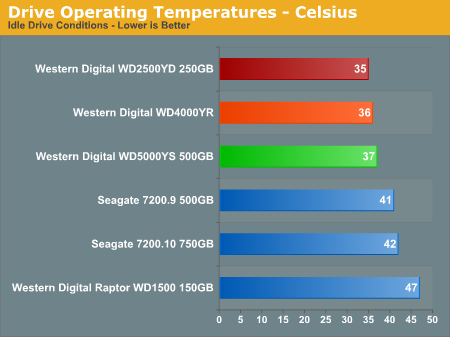Western Digital WD2500YD: Enterprise on the Desktop
by Gary Key on June 24, 2006 10:00 AM EST- Posted in
- Storage
Acoustics
We have revised our acoustics testing methodology. Our acoustic test utilizes our standard test bed components but we implement AMD's Cool'n'Quiet technology and turn off the case fans to isolate as much case noise as possible during testing. Our OCZ power supply is virtually silent in these tests along with our fanless Asus 7600GS video card providing a further decrease in our case's acoustical ambience.
Our acoustic tests are designed to measure the decibel levels while the system is at idle and also under load while running the General Hard Disk Drive Usage benchmark within PCMark 2005. We found through trail and error this particular benchmark produces controlled readings across a wide range of applications within the benchmark. This particular benchmark utilizes 60% reads and 40% writes within the trace playback file.
The measurements are taken at a distance of 5 millimeters from the rear and front of the drive being tested in order to minimize surrounding environmental noise. The reported measurements are based on an A-weighted decibel score that measures frequencies similar to the way the human ear responds to sound. We take a total of three measurements for each test. We then subtract the high and low scores and arrive at our findings by reporting the remaining score.


The WD2500YD is one of the quietest drives we have ever tested. In fact, the current RE and RE2 lineup are very quiet at idle and while under load. Our subjective opinion is that the seek requests are very muted for this drive and it was difficult to notice the drive's noise levels over the power supply fan during most read/write operations. We did notice a slight thumping noise in our Nero Recode benchmark that would occur during continuous data streaming. Our base db(A) level in the room at time of testing was 24 db(A).
Thermals
Our thermal tests utilize sensor readings via the S.M.A.R.T. (Self-Monitoring, Analysis and Reporting Technology) capability of the drives and are reported by utilizing the Active SMART 2.42 utility. We test our drives in an enclosed case environment without the front fan operational to simulate temperatures that could conceivably be reached in a SFF or HTPC case design. We typically find the reported numbers drop anywhere from 18% to 25% on average when the front fan is operational.


We expected the WD2500YD to run cool due to its size and platter count. It did not disappoint us in either test as even the casing remained cool to the touch after hours of continuous testing. Remember that these results represent something of a worst-case scenario, as they are recorded in an enclosed Gigabyte case without the front fan operating. If you plan on using a quiet/poorly ventilated inflated case, you'll want to pay attention to these results.
Both the RE2 drives also ran very cool, but the casings were significantly warmer after continuous operation compared to the RE 250GB drive. Our room temperature at time of testing remained a stable 21C. The WD Raptor and the Seagate drives operated at significantly higher temperatures, although both are within their operating specifications. It is unlikely that higher temperatures would immediately cause a drive failure, but they can reduce the lifespan of a hard drive. We highly recommend cooling the hotter drives with a fan or by some other means.
We have revised our acoustics testing methodology. Our acoustic test utilizes our standard test bed components but we implement AMD's Cool'n'Quiet technology and turn off the case fans to isolate as much case noise as possible during testing. Our OCZ power supply is virtually silent in these tests along with our fanless Asus 7600GS video card providing a further decrease in our case's acoustical ambience.
Our acoustic tests are designed to measure the decibel levels while the system is at idle and also under load while running the General Hard Disk Drive Usage benchmark within PCMark 2005. We found through trail and error this particular benchmark produces controlled readings across a wide range of applications within the benchmark. This particular benchmark utilizes 60% reads and 40% writes within the trace playback file.
The measurements are taken at a distance of 5 millimeters from the rear and front of the drive being tested in order to minimize surrounding environmental noise. The reported measurements are based on an A-weighted decibel score that measures frequencies similar to the way the human ear responds to sound. We take a total of three measurements for each test. We then subtract the high and low scores and arrive at our findings by reporting the remaining score.


The WD2500YD is one of the quietest drives we have ever tested. In fact, the current RE and RE2 lineup are very quiet at idle and while under load. Our subjective opinion is that the seek requests are very muted for this drive and it was difficult to notice the drive's noise levels over the power supply fan during most read/write operations. We did notice a slight thumping noise in our Nero Recode benchmark that would occur during continuous data streaming. Our base db(A) level in the room at time of testing was 24 db(A).
Thermals
Our thermal tests utilize sensor readings via the S.M.A.R.T. (Self-Monitoring, Analysis and Reporting Technology) capability of the drives and are reported by utilizing the Active SMART 2.42 utility. We test our drives in an enclosed case environment without the front fan operational to simulate temperatures that could conceivably be reached in a SFF or HTPC case design. We typically find the reported numbers drop anywhere from 18% to 25% on average when the front fan is operational.


We expected the WD2500YD to run cool due to its size and platter count. It did not disappoint us in either test as even the casing remained cool to the touch after hours of continuous testing. Remember that these results represent something of a worst-case scenario, as they are recorded in an enclosed Gigabyte case without the front fan operating. If you plan on using a quiet/poorly ventilated inflated case, you'll want to pay attention to these results.
Both the RE2 drives also ran very cool, but the casings were significantly warmer after continuous operation compared to the RE 250GB drive. Our room temperature at time of testing remained a stable 21C. The WD Raptor and the Seagate drives operated at significantly higher temperatures, although both are within their operating specifications. It is unlikely that higher temperatures would immediately cause a drive failure, but they can reduce the lifespan of a hard drive. We highly recommend cooling the hotter drives with a fan or by some other means.










11 Comments
View All Comments
Calin - Monday, June 26, 2006 - link
On RealTimePricing a 150GB Raptor is at $260. Could you throw a comparation with one of the cheaper 147GB SCSI models (at around $350)? If one want more performance and consider paying $260 for a Raptor instead a bit less for three times the capacity, they could accept paying one and a half times the price for a third the capacity in a SCSI drive.With considerations of sound and heat, not only performance, of course.
Thanks